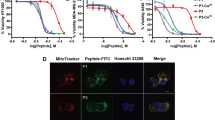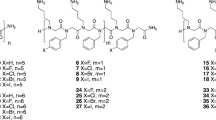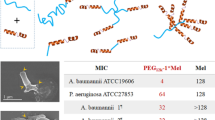Abstract
Small cationic amphiphilic α-helical peptides are emerging as agents for the treatment of cancer and infection, but they are costly and display unfavourable pharmacokinetics. Helical coordination complexes may offer a three-dimensional scaffold for the synthesis of mimetic architectures. However, the high symmetry and modest functionality of current systems offer little scope to tailor the structure to interact with specific biomolecular targets, or to create libraries for phenotypic screens. Here, we report the highly stereoselective asymmetric self-assembly of very stable, functionalized metallohelices. Their anti-parallel head-to-head-to-tail ‘triplex’ strand arrangement creates an amphipathic functional topology akin to that of the active sub-units of, for example, host-defence peptides and p53. The metallohelices display high, structure-dependent toxicity to the human colon carcinoma cell-line HCT116 p53++, causing dramatic changes in the cell cycle without DNA damage. They have lower toxicity to human breast adenocarcinoma cells (MDA-MB-468) and, most remarkably, they show no significant toxicity to the bacteria methicillin-resistant Staphylococcus aureus and Escherichia coli.
This is a preview of subscription content, access via your institution
Access options
Subscribe to this journal
Receive 12 print issues and online access
$259.00 per year
only $21.58 per issue
Buy this article
- Purchase on Springer Link
- Instant access to full article PDF
Prices may be subject to local taxes which are calculated during checkout



Similar content being viewed by others
References
Zanetti, M., Gennaro, R. & Romeo, D. Cathelicidins: a novel protein family with a common proregion and a variable C-terminal antimicrobial domain. FEBS Lett. 374, 1–5 (1995).
Lane, D. P. p53, guardian of the genome. Nature 358, 15–16 (1992).
Dürr, U. H. N., Sudheendra, U. S. & Ramamoorthy, A. LL-37, the only human member of the cathelicidin family of antimicrobial peptides. Biochim. Biophys. Acta Biomembr. 1758, 1408–1425 (2006).
Wu, W. K. K. et al. Emerging roles of the host defense peptide LL-37 in human cancer and its potential therapeutic applications. Int. J. Cancer 127, 1741–1747 (2010).
Baker, S. J. et al. Chromosome 17 deletions and p53 gene mutations in colorectal carcinomas. Science 244, 217–221 (1989).
Takahashi, T. et al. p53: a frequent target for genetic abnormalities in lung cancer. Science 246, 491–494 (1989).
Walensky, L. D. et al. Activation of apoptosis in vivo by a hydrocarbon-stapled BH3 helix. Science 305, 1466–1470 (2004).
Gavathiotis, E. et al. BAX activation is initiated at a novel interaction site. Nature 455, 1076–1081 (2008).
Cheng, R. P., Gellman, S. H. & DeGrado, W. F. Beta-peptides: from structure to function. Chem. Rev. 101, 3219–3232 (2001).
Appella, D. H., Christianson, L. A., Karle, I. L., Powell, D. R. & Gellman, S. H. Beta-peptide foldamers: robust helix formation in a new family of beta-amino acid oligomers. J. Am. Chem. Soc. 118, 13071–13072 (1996).
Johnson, L. M. & Gellman, S. H. in Methods in Enzymology (ed. Keating, A. E.) 407–429 (Methods in Protein Design series Vol. 523 Academic, 2013).
Davis, J. M., Tsou, L. K. & Hamilton, A. D. Synthetic non-peptide mimetics of alpha-helices. Chem. Soc. Rev. 36, 326–334 (2007).
Azzarito, V., Long, K., Murphy, N. S. & Wilson, A. J. Inhibition of α-helix-mediated protein–protein interactions using designed molecules. Nature Chem. 5, 161–173 (2013).
Lehn, J. M. et al. Spontaneous assembly of double-stranded helicates from oligobipyridine ligands and copper(I) cations: structure of an inorganic double helix. Proc. Natl Acad. Sci. USA 84, 2565–2569 (1987).
Albrecht, M. & Fröhlich, R. Controlling the orientation of sequential ligands in the self-assembly of binuclear coordination compounds. J. Am. Chem. Soc. 119, 1656–1661 (1997).
Torelli, S., Delahaye, S., Hauser, A., Bernardinelli, G. & Piguet, C. Ruthenium(II) as a novel labile partner in thermodynamic self-assembly of heterobimetallic d–f triple-stranded helicates. Chem. Eur. J. 10, 3503–3516 (2004).
Hahn, F. E., Schulze Isfort, C. & Pape, T. A dinuclear, triple-stranded helicate with a diamide-bridged catechol/benzenedithiol ligand. Angew. Chem. Int. Ed. 43, 4807–4810 (2004).
Rice, C. R., Baylies, C. J., Jeffery, J. C., Paul, R. L. & Ward, M. D. Mononuclear Cu(II) and triple helical dinuclear Co(II) complexes of a new potentially tetradentate ligand containing inequivalent bidentate units. Inorg. Chim. Acta 324, 331–335 (2001).
Hannon, M. J., Bunce, S., Clarke, A. J. & Alcock, N. W. Spacer control of directionality in supramolecular helicates using an inexpensive approach. Angew. Chem. Int. Ed. 38, 1277–1278 (1999).
Constable, E. C., Heirtzler, F. R., Neuburger, M. & Zehnder, M. Directional ligands in helicate selfassembly. Supramol. Chem. 5, 197–200 (1995).
Albrecht, M., Napp, M., Schneider, M., Weis, P. & Frohlich, R. Kinetic thermodynamic control of the self-assembly of isomeric double-stranded dinuclear titanium(IV) complexes from a phenylalanine-bridged dicatechol ligand. Chem. Commun. 409–410 (2001).
Schulze Isfort, C., Kreickmann, T., Pape, T., Frohlich, R. & Hahn, F. E. Helical complexes containing diamide-bridged benzene-o-dithiolato/catecholato ligands. Chemistry 13, 2344–2357 (2007).
Howson, S. E. & Scott, P. Approaches to the synthesis of optically pure helicates. Dalton Trans. 40, 10268–10277 (2011).
Kerckhoffs, J. M. C. A. et al. Enantiomeric resolution of supramolecular helicates with different surface topographies. Dalton Trans. 734–742 (2007).
Hotze, A. C. G. et al. Supramolecular iron cylinder with unprecedented DNA binding is a potent cytostatic and apoptotic agent without exhibiting genotoxicity. Chem. Biol. 15, 1258–1267 (2008).
Cardo, L., Sadovnikova, V., Phongtongpasuk, S., Hodges, N. J. & Hannon, M. J. Arginine conjugates of metallo-supramolecular cylinders prescribe helicity and enhance DNA junction binding and cellular activity. Chem. Commun. 47, 6575–6577 (2011).
Yu, H. et al. Metallosupramolecular complex targeting an α/β discordant stretch of amyloid β peptide. Chem. Sci. 3, 3145–3153 (2012).
Howson, S. E. et al. Origins of stereoselectivity in optically pure phenylethaniminopyridine tris-chelates M(NN′)3n+ (M=Mn, Fe, Co, Ni and Zn). Dalton Trans. 40, 10416–10433 (2011).
Howson, S. E. et al. Self-assembling optically pure Fe(A–B)3 chelates. Chem. Commun. 1727–1729 (2009).
Howson, S. E. et al. Jahn–Teller effects on p-stacking and stereoselectivity in the phenylethaniminopyridine tris-chelates Cu(NN′)32+. Dalton Trans. 41, 4477–4483 (2012).
Howson, S. E. et al. Optically pure heterobimetallic helicates from self-assembly and click strategies. Dalton Trans. 42, 14967–14981 (2013).
Howson, S. E. et al. Optically pure, water-stable metallo-helical ‘flexicate’ assemblies with antibiotic activity. Nature Chem. 4, 31–36 (2012).
Brabec, V. et al. Metallohelices with activity against cisplatin-resistant cancer cells; does the mechanism involve DNA binding? Chem. Sci. 4, 4407–4416 (2013).
Hunter, C. A. & Sanders, J. K. M. The nature of π–π interactions. J. Am. Chem. Soc. 112, 5525–5534 (1990).
Grimme, S. Do special noncovalent π–π stacking interactions really exist? Angew. Chem. Int. Ed. 47, 3430–3434 (2008).
Hannon, M. J., Painting, C. L., Jackson, A., Hamblin, J. & Errington, W. An inexpensive approach to supramolecular architecture. Chem. Commun. 1807–1808 (1997).
Ren, S. X. et al. FK-16 derived from the anticancer peptide LL-37 induces caspase-independent apoptosis and autophagic cell death in colon cancer cells. PLoS ONE 8, e63641 (2013).
Fu, D., Calvo, J. A. & Samson, L. D. Balancing repair and tolerance of DNA damage caused by alkylating agents. Nature Rev. Cancer 12, 104–120 (2012).
Siddik, Z. H. Cisplatin: mode of cytotoxic action and molecular basis of resistance. Oncogene 22, 7265–7279 (2003).
Bonner, W. M. et al. γH2AX and cancer. Nature Rev. Cancer 8, 957–967 (2008).
Krishan, A. Rapid flow cytofluorometric analysis of mammalian cell cycle by propidium iodide staining. J. Cell Biol. 66, 188–193 (1975).
Nicoletti, I., Migliorati, G., Pagliacci, M. C., Grignani, F. & Riccardi, C. A rapid and simple method for measuring thymocyte apoptosis by propidium iodide staining and flow cytometry. J. Immunol. Methods 139, 271–279 (1991).
Kajstura, M., Halicka, H. D., Pryjma, J. & Darzynkiewicz, Z. Discontinuous fragmentation of nuclear DNA during apoptosis revealed by discrete ‘sub-G1' peaks on DNA content histograms. Cytometry A 71A, 125–131 (2007).
Grimme, S., Ehrlich, S. & Goerigk, L. Effect of the damping function in dispersion corrected density functional theory. J. Comput. Chem. 32, 1456–1465 (2011).
Granovsky, A. A. Firefly version 7.1.G; http://classic.chem.msu.su/gran/firefly/index.html
Schmidt, M. W. et al. General atomic and molecular electronic structure system. J. Comput. Chem. 14, 1347–1363 (1993).
Deeth, R. J., Anastasi, A., Diedrich, C. & Randell, K. Molecular modelling for transition metal complexes: dealing with d-electron effects. Coord. Chem. Rev. 253, 795–816 (2009).
Deeth, R. J., Fey, N. & Williams-Hubbard, B. DommiMOE: an implementation of ligand field molecular mechanics in the molecular operating environment. J. Comput. Chem. 26, 123–130 (2005).
Andrews, J. M. Determination of minimum inhibitory concentrations. J. Antimicrob. Chemother. 48, 5–16 (2001).
Coles, S. J. & Gale, P. A. Changing and challenging times for service crystallography. Chem. Sci. 3, 683–689 (2012).
Acknowledgements
The authors thank the EPSRC and the University of Warwick for financial support, and the National Crystallographic Service for recording the X-ray data (structure code AF20)50.
Author information
Authors and Affiliations
Contributions
A.D.F. performed computational work under the direction of D.J.F. A.D.F. and R.A.K. synthesized and characterized the compounds following early studies by S.E.H., and developed and conducted stability studies. R.A.K. and Q.M.A.A. performed the biological work under the direction of R.M.P. P.G. developed a synthesis of [Fe2(C25H20N4)3]Cl4 and performed stability studies. G.J.C. solved and refined the X-ray crystal data. D.H.S. conducted the antimicrobial experiments under the direction of D.I.R. P.S. conceived and directed the project, interpreted the data and wrote the manuscript.
Corresponding author
Ethics declarations
Competing interests
The authors declare no competing financial interests.
Supplementary information
Supplementary information
Supplementary information (PDF 2831 kb)
Supplementary information
Crystallographic data for compound RC,∆Zn,HHT-[Zn2L3a3][ClO4]4.4H2O (CIF 974 kb)
Rights and permissions
About this article
Cite this article
Faulkner, A., Kaner, R., Abdallah, Q. et al. Asymmetric triplex metallohelices with high and selective activity against cancer cells. Nature Chem 6, 797–803 (2014). https://doi.org/10.1038/nchem.2024
Received:
Accepted:
Published:
Issue Date:
DOI: https://doi.org/10.1038/nchem.2024
This article is cited by
-
Self-assembly of an anion receptor with metal-dependent kinase inhibition and potent in vitro anti-cancer properties
Nature Communications (2021)
-
Cellular pharmacology studies of anticancer agents: recommendations from the EORTC-PAMM group
Cancer Chemotherapy and Pharmacology (2018)
-
Making head–head–tails of it
Nature Chemistry (2014)



